If you’re shopping for LED strip lights, you’ve probably come across a few small-sized options that caught your eye. But do narrow LED strips that meet your lighting needs really exist on the market today?
Small LED strip lights are often perfect for tight spaces or for creating subtle ambiance. However, while these mini LED light strips may seem like a convenient option, they may not be suitable for all applications.
In this article, we’ll explore the unique features and potential drawbacks of small LED strips. So, if you’re curious about this and want to know if you can buy the thin led strip you want, read on to get useful information.
- What Is A Small LED Strip?
- Types of Small LED Strip Lights
- Does the Brightness of Small LED Strip Lights Decrease?
- Do Small High Density LED Strip Lights Exist?
- Is There An Overheating Crisis In Narrow LED Strip Lights?
- How to Solve Overheating Problem of Small LED Strips?
- Can Narrow LED Strips Lights Be Waterproofed?
- How Can You Control Small LED Strip?
- FAQs
What Is A Small LED Strip?
Small led strips have a very small footprint and hardly take up any space when installed, making them perfect for under-cabinet lighting and small rooms. Typically, the PCB width of small led strip lights is under 6mm. The smallest led light strip is 2.6mm car strip.
As a type of LED strip lights, mini led light strips still operate at low voltage, so you can use small adapters or even batteries to power them, or mount them on your computer desk, gaming table, or bedroom bedhead via a USB port. Small thin led light strips allow any background lighting and DIY lighting to be added to your home.
- Width of led small strip lights: 2.6mm/0.1in, 2.7mm/0.11in, 3mm/0.12in, 3.3mm/0.13in, 3.5mm/0.14in, 4mm/0.16in, 5mm/0.2in, 6mm/0.24in
Types of Small LED Strip Lights
Usually, we distinguish the types of LED strips by color. According to the LED color, the small led strip lights can be divided into single-color small led strips and color-changing small led strips.
Among them, the single-color small led strip lights include 2700K, 3000K, 4000K, 5000K, 6000K, 7000K white colors and red, green, blue, yellow, pink, purple, ice blue, amber, CCT, and UV blacklight; the color-changing small led strip lights include RGB, addressable RGB (RGBIC), and addressable RGBW colors.
According to the LED light-emitting mode, it can be divided into top-emitting small led strip lights and side-emitting small led strip lights.
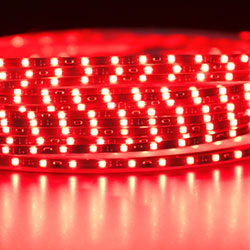
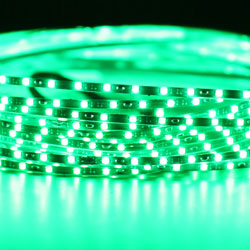
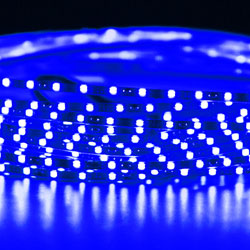
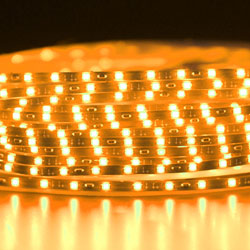
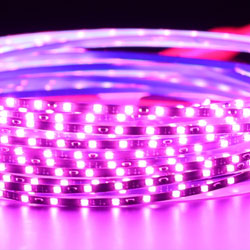
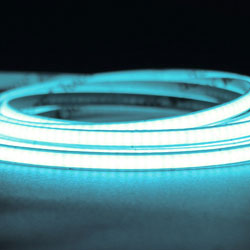
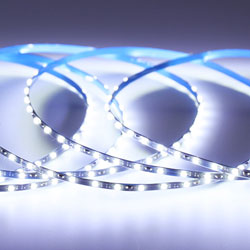
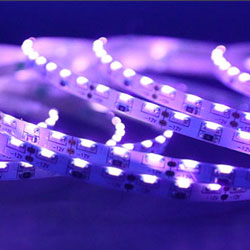
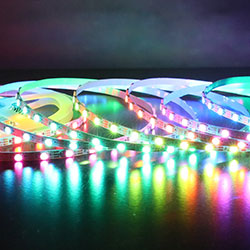
Does the Brightness of Small LED Strip Lights Decrease?
The width of the circuit board of the small strip limits the size of the LED chip. LED chips used in the current market for thin LED light strips are: SMD335, SMD020, SMD0603, SMD2020, SMD2025, SMD2110, SMD2216, SMD2835, SMD3528, SMD3030, SMD3014, SMD3535, SMD3838, SMD4040, SMD5050, SMD5730, COB chip-on-board LED.
The brightness value of LED strip lights depends on the lumens. The lumen is not quite the same for each LED chip. The higher the number of LEDs on a strip, the higher the lumen value.
A narrow led strip has at least 60 LEDs per meter, generally 6-7 lumens per LED, which works out to 360-420 lumens per meter, which can illuminate a 242 square feet area, enough for under cabinet lighting and accent lighting.
| Lighting tasks | Recommended Lumens |
| Accent lighting (Stairs, Swim Pool) | 150-250LM/Ft |
| Nearby working lighting (Cabinet) | 175-550LM/Ft |
| Long-distance task lighting (Ceiling) | 350-1200LM/Ft |
| Indirect lighting (Backlight) | 375-1200LM/Ft |
| Sign (Hoarding) | 500-1200LM/Ft |
Do Small High Density LED Strip Lights Exist?
The construction of LED strips causes us to pursue high-density lighting for more uniform light. The dense LED arrangement minimizes the dark area between two adjacent LEDs.
The most notable of high-density strips is the COB strip. Chip-on-board technology allows more LEDs on a narrow PCB, a meter up to 480 for single color, and 600 for 2-wire CCT.
And for SMD LED strips, the small size of the surface mount devices also fits well into this narrow PCB width. There are 300 SMD2110 LEDs in a strip length of one meter, with 3.3 mm (0.13in) board width.
- LED density (per meter) of small strip lights: 60, 72, 90, 96, 120, 160, 168, 180, 192, 240, 280, 300 for SMD LED, 320, 384, 480 for COB LED
- LED density (per foot) of small strip lights: 18, 22, 27, 29, 36, 48, 51, 55, 58, 73, 85, 91 for SMD LED, 97, 117, 146 for COB LED
Is There An Overheating Crisis In Narrow LED Strip Lights?
Narrow LED strip lights are not necessarily more likely to overheat than wider strip lights. In fact, the amount of heat generated by an LED strip is largely determined by the power and current flowing through the strip, as well as the quality of the LED chip and the thermal management of the strip.
While narrow LED strips have less surface area to dissipate heat, this can be compensated for by using high-quality materials and designing strips with good thermal management features. For example, some LED strip lights have heat sinks or other built-in cooling components to help dissipate heat and prevent overheating.
It is worth noting, however, that LED strips generate heat as they build up over time. If they are used in a warm environment, you need to pay special attention to this. This is because, in addition to their self-generated heat, the excessive air temperature will also increase the temperature of the strip.
How to Solve Overheating Problem of Small LED Strips?
There are several ways to address the problem of overheating with small LED strip lights:
- Check the power supply: Overheating can occur if the power supply is not providing enough power to the LED strip. Make sure the power supply is rated correctly for the LED strip and that the voltage and current are within the specifications of the LED strip.
- Improve ventilation: Make sure the LED strip is not placed in an area where air circulation is limited, which can lead to overheating. Provide adequate ventilation by ensuring there is enough space around the LED strip for air to circulate.
- Reduce operating time: Overheating can occur if the LED strip is operated continuously for long periods of time. Consider reducing the operating time or using a timer to turn off the LED strip periodically to allow it to cool down.
- Use a heat sink: Adding a heat sink to the LED strip can help dissipate heat and prevent overheating. There are heat sinks – mini LED profiles designed specifically for LED strips that can be attached to the back of the strip and with a cover to diffuse light.
- Add a cooling fan: If ventilation and heat sinks are not enough to cool the LED strip, consider adding a cooling fan to improve air flow and dissipate heat.
- Consider using larger LED strip lights: If overheating is a persistent problem, consider using wider LED strip lights with better thermal management to provide more surface area for heat dissipation.
In short, you need to follow the usage of ultra-narrow LED strips to make it perfect for your lighting.
Can Narrow LED Strips Lights Be Waterproofed?
Yes, small LED strip lights can be treated to be waterproof. In fact, waterproofing is a common feature for many LED strip lights, including narrow ones.
There are two major ways to make narrow LED strip lights waterproof. One way is to use a transparent silicone housing to seal the strip. Another way is to use a waterproof casing or enclosure – milky white silicone led diffuser tube. These two ways all protect the strip from water and other environmental factors.
*A Small Tip: LED strip lights with silicone waterproof casing are also known as Neon LED strips.
It’s also important to note that while waterproofing can help protect the LED strip from water damage, it does not make the strip immune to overheating or other types of damage. It’s still important to follow proper installation and usage guidelines to ensure the longevity and performance of the LED strip light.
How Can You Control Small LED Strip?
LED light strips are controlled by an external controller to change the color and brightness of the LEDs.
If you want to operate the small LED lights through an application on your smartphone, you need a WiFi or Bluetooth LED controller. If you are used to remote control, then all you need is a controller that is compatible with RF or IR technology.
The special point about LED strip lights is that you can use voice commands to achieve control of the lights, at which point you need to pay attention to whether this controller is compatible with Alexa or Google Assistant.
There are also small dimmers that allow you to simply turn on, turn off, and adjust the light brightness, which is often used for under-cabinet lighting and other convenience lighting.